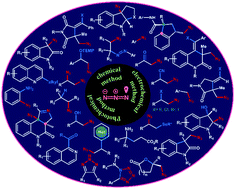Chemical versatility of azide radical: journey from a transient species to synthetic accessibility in organic transformations
Abstract
The generation of azide radical (N3˙) occurs from its precursors primarily via a single electron transfer (SET) process or homolytic cleavage by chemical methods or advanced photoredox/electrochemical methods. This in situ generated transient open-shell species has unique characteristic features that set its reactivity. In the past, the azide radical was widely used for various studies in radiation chemistry as a 1e− oxidant of biologically important molecules, but now it is being exploited for synthetic applications based on its addition and intermolecular hydrogen atom transfer (HAT) abilities. Due to the significant role of nitrogen-containing molecules in synthesis, drug discovery, biological, and material sciences, the direct addition onto unsaturated bonds for the simultaneous construction of C–N bond with other (C–X) bonds are indeed worth highlighting. Moreover, the ability to generate O- or C-centered radicals by N3˙ via electron transfer (ET) and intermolecular HAT processes is also well documented. The purpose of controlling the reactivity of this short-lived intermediate in organic transformations drives us to survey: (i) the history of azide radical and its structural properties (thermodynamic, spectroscopic, etc.), (ii) chemical reactivities and kinetics, (iii) methods to produce N3˙ from various precursors, (iv) several significant azide radical-mediated transformations in the field of functionalization with unsaturated bonds, C–H functionalization via HAT, tandem, and multicomponent reaction with a critical analysis of underlying mechanistic approaches and outcomes, (v) concept of taming the reactivity of azide radicals for potential opportunities, in this review.



 Please wait while we load your content...
Please wait while we load your content...